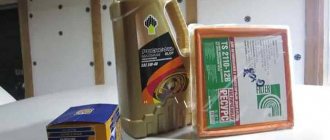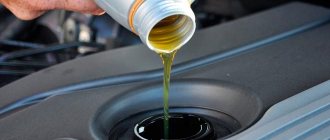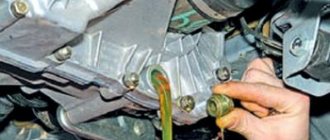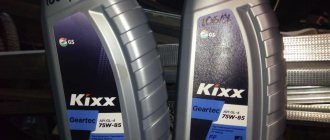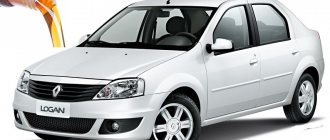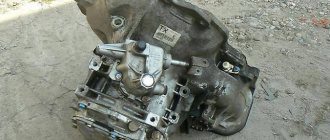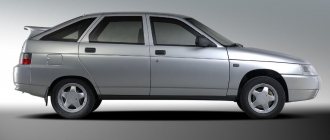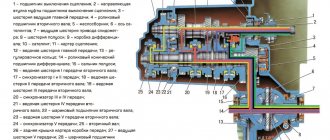| № | Name | Rating | Nomination |
| 1 | ELF Evolution 900NF | 4.72 | Balance of price and quality |
| 2 | TOTAL Quartz 9000 Energy | 4.70 | Best for long drain intervals |
| 3 | LUKOIL Lux SN/CF | 4.68 | The most adapted to Russian realities |
| 4 | SHELL Helix HX7 | 4.67 | Best for northern regions. The most popular and cheapest |
| 5 | Rosneft Magnum Ultratec | 4.55 | The best according to JSC AVTOVAZ |
An oil film envelops engine parts and minimizes their wear. Additives that manufacturers generously add to their products can increase service life, reduce toxicity, reduce friction and reduce fuel consumption. The products of different brands contain their own “cocktail”, which determines the properties of the oil.
Motor range
First, let's look at the list of engines installed in the Lada Granta depending on the configuration:
- 1.6, 8 valves, 82 l. With. (11183-50)
- 1.6, 8 valves, 87 l. With. (11186)
- 1.6, 8 valves, 90 l. p., 21116)
- 1.6, 16 valves, 98 l. With. (21126)
- 1.6, 16 valves, 106 l. With. (21127)
The design of lubrication systems for Lada Granta engines is absolutely the same, which simplifies the process of maintenance and interchangeability of parts. The only difference is with motor 21126, which is equipped with special channels for supplying oil to the valves. The channels are built into the cylinder head.
Oil selection
When choosing the right oil for Lada Granta, many are guided by advice from experienced owners, that is, real reviews on the Internet. But we must admit that this information is advisory in nature, and it will not be enough. It would be much safer to pay attention to the manufacturer's instructions. Thus, AvtoVAZ recommends filling Granta with oils with SJ and SL parameters, API or ACEA class.
Let's take a closer look at the recommended oils:
- Lukoil-Lux – QW-40, 5W-20, 10W-40 (viscosity grade), API – SL/CF
- Lux – 10W-40, B5/D3, SL/CF
- Lux Best – 10W-40, SJ/CF
- TNK Magnum Super – 5W-40, 15W-50, SJ/CF
- Rosneft Maximum/Optimum/Premium – 10W-30, 5W40; SM, CF
- Tatneft Ultra Optima 5W-40, 10W-40, SL-CF
- G-Energy S Synth – 10W-40, 15W-40, SL/CF
- Sibmotor Super – 10W-40, 15W-40, SJ/SF
- Esso Ultra – 10W-40, SL/CF
- GT Turbo SM – 10W-40, SM
- Mobil New Life/Peak Life/Super 2000 X1/Super 3000X1/ESP – 5W-40, 10W-40, SW-40, 5W-30; SJ/SL
- Formula – 5W-30, S/SL/SM/CF
- Shell Helix/Plus/Plus Extra/Ultra – 10W-40, 5W-40; SL/CF
- ZIC A Plus – 5W-30, 10W-40, SL
TOP 5 best oils for Lada Granta
This is my personal choice based on experience and analysis of information on the Internet. It is for informational purposes only and is not a call to purchase. The rating was not paid for by anyone, I do not cooperate with manufacturers, so there is no “ordering” here.
#1SHELL Helix HX8 Synthetic 5W-40 Best price Yandex Market #2Mobil Super 3000 X1 5W-40 Best price Yandex Market #3TOTAL Quartz 9000 5W-40 Best price Yandex Market #4LUKOIL Luxury semi-synthetic SL/CF 10W-40 Best price Yandex Market # 5Rosneft Maximum 5W-40 SG/CD Best price Yandex Market
SHELL Helix HX8 Synthetic 5W-40
4.9 Customer rating 9 reviews Read reviews Full review RUR 689
for 1l. 5W-40 SHELL Viscosity 5W-40APISN/CF, SN-PLUSACEAA3/B3, A3/B4 Pour point -50°C Dynamic viscosity CSS-Kinematic viscosity at 100°C14.60 mm2/s Laboratory analyzes IndicatorValue/Unit of measurement
| Density at 15°C | – |
| Kinematic viscosity at 100℃ | 14.6 mm²/s |
| Kinematic viscosity at 40°C | 87.43 mm²/s |
| Dynamic viscosity (CCS) at -30°C | – |
| Dynamic viscosity (MRV) at -35°C | – |
| Viscosity index | 175 |
| Freezing point | -50°C |
| Flash point | 235°C |
| Sulfated ash content | 1.14% wt. |
| API clearance | SN/SN PLUS/CF |
| ACEA approval | A3/B3, A3/B4 |
| Base number | 12.38 mg. KOH per 1 g |
| Acid number | 1.63 mg. KOH per 1 g |
| Sulfur content | 0.250 % |
| Fourier IR Spectrum | – |
| NOACK | – |
Tolerances Tolerances:
- MB-Approval 229.3
- VW Standard 502.00, 505.00
- Renault RN 0700, RN 0710
Matches:
- Fiat (FCA) 9.55535-M2
A little about the oil The oil received high marks according to test results - and for good reason. It perfectly washes the engine, adapts to any conditions of use, and retains its properties throughout the recommended mileage. Ideal for turbocharged engines, used diesel engines, operating in difficult conditions.
We can safely say that in this case the quality not only matches the price, but significantly exceeds it; according to the analysis results, the oil is more similar to the premium segment. Meets modern standards and can be poured into modern engines that meet the tolerances. It is optimal to use it for city traffic with a high load; in the “highway” mode it works well, but showed high consumption.
Advantages
- Latest API clearance.
- High engine protection when driving in urban conditions.
- Maintains fluidity down to at least -35 degrees.
- Rich additive package.
- Pure base foundation.
Flaws
- Relatively high consumption on the highway.
Mobil Super 3000 X1 5W-40
4.3 Customer rating 36 reviews Read reviews Full review RUR 524
for 1l. 5W-40 Viscosity 5W-40APISN/SMACEAA3/B3, A3/B4 Pour point -44°C Dynamic viscosity CSS6048 mPas at -30℃Kinematic viscosity at 100°C13.76 mm²/s Laboratory tests IndicatorValue/Unit of measurement
| Kinematic viscosity at 100℃ | 13.76 mm²/s |
| Kinematic viscosity at 40°C | 83.51 mm²/s |
| Sulfated ash content | 1.14% |
| Phosphorus content | 987 mg/kg |
| Density at 15°C | 0.855 kg/l |
| Flash point | 232°C |
| Freezing point | -44°C |
| API clearance | SN/SM |
| ACEA approval | A3/B3, A3/B4 |
| Dynamic viscosity (CCS) at -30°C | 6048 |
| Dynamic viscosity (MRV) at -35°C | – |
| Base number | 10.01 mg. KOH for 1g. |
| Acid number | 2.32 mg. KOH for 1g. |
| Fourier IR Spectrum | – |
| NOACK | 10.9% |
Approvals Mobil Super 3000 X1 exceeds or meets the following requirements:
- ACEA A3/B3, A3/B4;
- API SN/SM;
- AAE (STO 003) Group B6.
Has the following equipment manufacturer approvals for use:
- MB-Approval 229.3;
- VW 502 00/505 00;
- BMW Longlife-01;
- Porsche A40;
- Peugeot/Citroën Automobiles B71 2296;
- Renault RN0710 / RN0700;
- AVTOVAZ (Lada cars).
ExxonMobil recommends using this oil where:
- API CF;
- Opel GM-LL-B-025.
A little about the oil The oil is perfect for both urban use and high-speed highway travel. I would not recommend this product to owners of older cars, due to the overly aggressive cleaning of deposits, which can lead to engine failure.
Advantages
- Universal oil, suitable for all types of modern internal combustion engines.
- Low waste consumption.
- Good cleaning properties.
- Thick film, reliable engine protection even under heavy loads.
- Pure base foundation.
- Stability under load.
Flaws
- Owners of old cars note the excessive cleaning properties of the composition, which do not always have a positive effect on the condition of the unit - the oil is designed for more modern models.
- Cold start not lower than -25 degrees.
TOTAL Quartz 9000 5W-40
4.2 Customer rating 6 reviews Read reviews Full review RUB 640.
for 1l. 5W-40 Viscosity 5W-40APISM/CFACEAA3/B4 Pour point -44°C Dynamic viscosity CSS5809 mPa*s at -30℃ Kinematic viscosity at 100°C14.79 mm²/s Laboratory analyzes IndicatorValue/Unit of measurement
| Viscosity grade | 5W-40 |
| Density at 15°C | 854.3 kg/m³ |
| Kinematic viscosity at 40°C | 90.70 mm²/s |
| Kinematic viscosity at 100℃ | 14.79 mm²/s |
| Viscosity index | 171 |
| Flash point | 238°C |
| Freezing point | -44°C |
| API clearance | SM/CF |
| ACEA approval | A3/B4 |
| Dynamic viscosity (CCS) at -30°C | 5809 mPas |
| Base number | 9.91 mg. KOH for 1 g. |
| Acid number | 2.38 mg. KOH for 1 g. |
| Sulfated ash content | 1.12% |
| Sulfur content | 0.243% |
| Fourier IR Spectrum | – |
| NOACK | 10.3% |
Tolerances
- PSA B71 2296;
- VW 502.00/505.00;
- BMW LL-01;
- MB 229.3;
- PORSCHE A40.
A little about TOTAL QUARTZ 9000 5W40 oil - a modern oil made on the basis of the best developments and technologies. Suitable for any car engine, incl. HBO and internal combustion engine components are cleaned, increasing service life. The cost of synthetics is one of the highest in comparison with competitors, there are many fakes, but the company itself is a leader in the fuel and lubricants market, received a maximum rating of 98 out of 100 according to reviews on the website partreview.ru. Advantages
- Suitable for highly accelerated and loaded engines, internal combustion engines with turbines and hybrid installations.
- Adapted for difficult conditions - high-speed driving, overheating.
- Pure base foundation.
- Creates a durable oil film.
Flaws
- After 5-7 thousand kilometers, oil consumption is possible. Although very minor.
- A large number of fakes are on sale.
- When the temperature is -30 or more, problems with starting diesel engines are possible. In this case, it is better to buy a 0W zero.
LUKOIL Lux semi-synthetic SL/CF 10W-40
4.6 Customer rating 5 reviews Read reviews Full review RUR 350
for 1l. 10w-40 Lukoil Viscosity 10w-40APISL/CFACEA-Pour point-38°C Dynamic viscosity CSS-Kinematic viscosity at 100°C14.22 mm²/s Laboratory tests IndicatorValue/Unit of measurement
| Kinematic viscosity at 40°C | 93.60 mm²/s |
| Kinematic viscosity at 100℃ | 14.22 mm²/s |
| Dynamic viscosity (CCS) at -25°C | – |
| Dynamic viscosity (MRV) at -30°C | – |
| Density at 15°C | – |
| Viscosity index | 157 |
| Freezing point | -38°C |
| Flash point | 222°C |
| Sulfated ash content | 1.03% |
| API clearance | SL/CF |
| ACEA approval | – |
| Base number | 8.04 mg KOH per 1 g |
| Acid number | 1.69 mg KOH per 1 g |
| Sulfur content | 0.561% |
| Fourier IR Spectrum | Based on VHVI hydrocracking + mineral water |
| NOACK | – |
Tolerances
- API SL/CF
- OJSC "UMZ"
- JSC "AVTOVAZ"
A little about the oil High-quality and inexpensive domestic semi-synthetic with the characteristics of synthetic oil. The composition includes organic molybdenum, can easily withstand heavy loads and is excellent for used engines of domestic and foreign production.
Video
Engine 11186 is the minimum power unit in terms of power. which is standard equipment on Lada Granta and Lada Kalina cars. The VAZ 11186 engine is standardly coupled with a manual transmission. The start of serial production of the engine is in 2011. Environmental standards Euro-4.
The engine is structurally designed as an in-line gasoline four with a volume of 1586 cubic centimeters. Maximum power of 87 hp. reaches at 5100 rpm. Maximum torque of 140 Nm is produced at 3800 rpm.
It is the second iteration of the modification of the classic front-wheel drive engine 21083. The predecessor is the VAZ 21114 engine with a volume of 1.6 liters. The engine has an additional index VAZ 21116. The main difference is the use of a piston system on 11186, manufactured by AvtoVAZ OJSC, and not by Federal Mogul.
The declared engine life is 200,000 km. The actual mileage before the first major overhaul is not recorded. The Russian manufacturer does not have the practice of monitoring typed cars by mileage. According to existing unverified reviews, the actual mileage exceeds the service life of 21,114, but does not reach the declared one.
SOHC engine design diagram. One camshaft located at the top of the engine. Accordingly, we have 8 valves, 2 for each cylinder. The camshaft is driven by a belt. During operation, the belt does not require replacement, since the declared life of the belt coincides with the life of the engine. The belt tension is automatic and is designed by design.
Fuel supply system is injection with electronic control. Spark plugs are standard A17DVRM. The spark is supplied by the ignition unit according to the 2-2 scheme, i.e. spark is supplied to two cylinders at the same time
Lada cars
Currently, the domestic car manufacturer Lada offers fundamentally new models of its vehicles. The already legendary “kopecks”, “sixes”, “sevens” and other models were replaced by new cars, such as Vesta, XRay, Granta, Largus Cross. These cars look completely different from the usual “oldies”. There is a European image here, which is inherent in modern cars from abroad. Plus, the cost of Lada cars is very affordable and affordable for many of our compatriots. For this reason, at the moment, interest in modern Ladas is increasing every day.
One of the most affordable cars from Lada is the Granta model. If you need a new car without any unnecessary bells and whistles and at a low price, then the Lada Granta is perhaps the most worthy option on the market. This car option can be considered for frequent trips outside the city - to the country, to the village. The vehicle copes well with these functions.
Modifications applied to the engine
To ensure normal temperature conditions of 95C when using gasoline with an octane rating of at least 95, the cooling system has been modified. Changed to increase the area and flow area of the cooling channels, and increased the volume of antifreeze poured.
Changes were made to the internal channels of the engine head. To ensure increased second consumption of antifreeze, a pump from a 16-valve engine is installed on the engine. In addition, the design of the thermostat has been changed.
In order to reduce fuel consumption and increase engine reliability, major modifications have been made. The engine is equipped with a connecting rod and piston group that is lightened by almost 40% compared to the VAZ-21114 engine. This change not only reduced the weight of the engine itself, but, more importantly, reduced the inertia of the entire system. The design innovation made it possible to increase the declared service life before major repairs.
Externally, the motor also differs from its predecessor. A longer intake tract was installed, which made it possible to achieve a higher torque value and bring the performance of the 8-valve engine closer to the 16-valve engine.
The exhaust manifold has elongated pipes and a more voluminous resonator, which significantly facilitates the engine's breathing at the exhaust, since the aerodynamic resistance of the exhaust tract is reduced.
The generator mounting bracket has been changed to make it possible to adjust the drive belt using an eccentric tensioner roller. This design is also used on VAZ Vesta car engines.
Maintenance frequency and cost
The regulated maintenance interval is 15,000 km or 1 year, whichever comes first. The calendar maintenance period is set based on the criteria for maintaining the lubricating properties of the engine oil, taking into account its possible oxidation. The air supply system filter element is changed every 30,000 km, as are the spark plugs.
The first valve adjustment is performed after running in the engine during TO-0, then at 15,000 km during TO-1 and then at 30,000 km intervals. At TO-5 (75,000 km), the oxygen sensor is changed, and the generator drive belt is changed at 90,000 km.
The average cost of maintenance, taking into account checking other vehicle systems without the cost of consumables, does not exceed 5,000 rubles.
Reviews
| № | Positive |
| 1. | Vitaly , 41 years old: after the first maintenance, I continue to pour domestic lubricant into the Rosneft brand motor, semi-synthetic class. Optimal price-quality ratio. |
| 2. | Victor , 33 years old: I bought Granta Liftback six months ago at a dealership and have already done several maintenances. The master recommended the domestic manufacturer Lukoil 10W - 40. |
| 3. | Gennady , 39 years old: the car is three months old, runs well, works well, no complaints. I use domestic Rosneft. |
| 4. | Konstantin , 29 years old: this is my first car, I strictly follow the requirements of the instructions, I only fill in domestic engine and transmission TatNeft, semi-synthetic class. |
| Negative | |
| 1. | Kirill , I don’t trust Russian lubricants, the quality is below average. I use ShellXelixUltra exclusively. The motor runs like a clock. |
| 2. | Vyacheslav , 36 years old: after the first maintenance, he drained the factory waste and filled it with ShellXelix. Even though the canister costs a third more, I am sure of the quality. |
| 3. | Mikhail , 37 years old: I didn’t listen to the recommendations of the technician at the service station, I fill ShellXelix myself and advise you. |
Conclusion What brand of oil to pour into the engine and gearbox is a purely individual matter. You should start from the cost of the canister and listen to the manufacturer’s recommendations. Otherwise, you risk voiding your warranty.
Basic faults
Structurally, it is possible to bend the valves when the timing belt breaks. Using only the original belt avoids this problem. The problem can arise due to poor assembly, which is rare, or when the belt tension system fails. In the event of an emergency, the camshaft and even the crankshaft may be bent.
After performing repairs without replacing the main and connecting rod bearings, the pressure in the oil system may drop and oil consumption may increase. It is not possible to determine whether the valve bends when the belt actually breaks under operating conditions, since there is no open manufacturer data on such a malfunction.
Replacing the timing belt is not regulated by maintenance programs.
Troubleshooting, misfire. Failure of the ignition unit. The malfunction occurs due to a defect in the block itself. The unit cannot be repaired and must be replaced entirely.
Overheat. Associated with contamination of the surface of the cooling radiator. Another reason is a malfunction of the thermostat element, which may become stuck in the open or closed position. The most common problem is that the thermostat element is stuck in the open position, which results in a lower operating temperature of the engine.
Valve knocking. This is normal wear and tear. Eliminated by selecting adjusting washers.
The engine stalls at idle or while driving. There is a problem with the electronic sensors that the motor is equipped with. Basically, the problem is solved by replacing the mass fuel flow sensor (MAF)
Idle speed fluctuates. The reason is a problem with the idle speed sensor or due to the presence of air leaks into the vacuum brake booster (it is necessary to check the pipelines for damage).
High idle speed. This malfunction indicates a break in the crankcase gas suction pipeline.
Possibilities for engine modification and tuning
As an option to increase engine power, it is possible to carry out chip tuning in order to remove restrictions on the environmental class. The overall percentage of power increase will not exceed 2-5%.
Replacing the camshaft. It is not economically feasible, just like installing a turbocharger. Replacing the camshaft and receiver will remove 100 hp from the engine. If you additionally modify the cylinder head channels, you can gain an additional 20 hp.
To carry out such modifications, it is first necessary to change the engine design from SOHC to DOHC. That is, it is necessary to replace the cylinder head with a 16 valve with two camshafts. Such a replacement will increase the possible power of the 8-valve engine to 120 hp. without significant impact on the overall engine life.
Sequence of actions when replacing the oil filter of Lada Granta Liftback with your own hands
- The machine is installed on a level platform (hydraulic lift), the engine oil is drained, and the hood is open.
- Using a special key with a chain cape, we twist the cleaner through the opening in the engine compartment. Without auxiliary equipment, it is difficult to tear it from its seat.
- Remove the cleaner.
- We wipe the seat, remove any residual waste, and check the integrity of the threads on the rod.
- Fill the new filter with 100 - 150 ml of new engine oil and install it in its original place.
It is important to know!!! The given algorithm of actions is relevant for an 8-valve engine. In a 16-valve design, oil and filter changes are carried out through the bottom of the engine compartment, since the valve covers are obstructed at the top.


